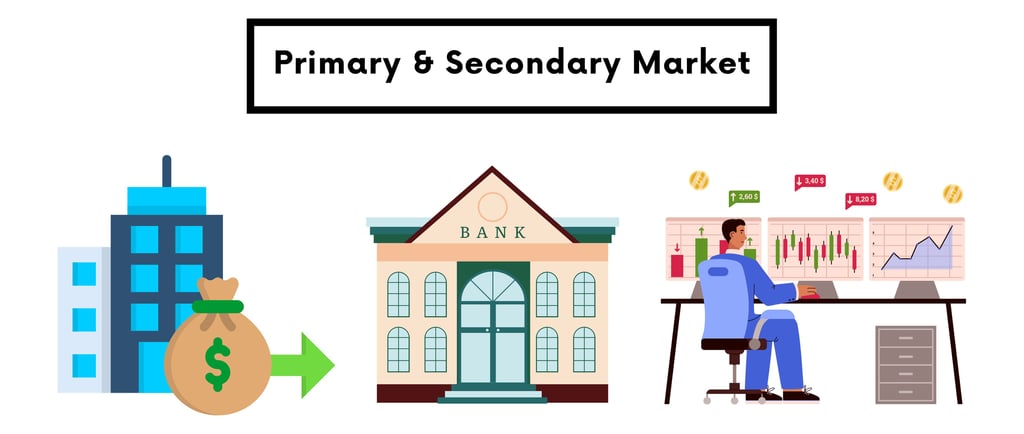Understanding Primary and Secondary Markets in the Stock Market


INTRODUCTION
If you are new to investing or trying to understand how the stock market functions, it is important to learn about two essential components of the financial system: the primary market and the secondary market. These two markets play different but equally important roles in how companies raise money and how investors buy and sell shares. In this blog, we will break down what primary and secondary markets are, how they work, and why both are crucial for the functioning of the economy and the investing world.
What Is the Primary Market?
The primary market is where securities are created and offered to investors for the first time. When a company decides to raise capital by issuing shares to the public, it does so in the primary market. This is commonly known as an Initial Public Offering or IPO. In the primary market, investors buy shares directly from the issuing company. The money raised from the sale goes directly to the company, which can then use it to fund business expansion, pay off debt, invest in research, or for other purposes. For example, when a private company decides to become public and lists its shares on a stock exchange, it goes through an IPO. During this process, the company works with investment banks to set a price for its shares and offer them to institutional and retail investors. Once the IPO is completed and shares are allotted, the company gets the funds and the shares become available for trading on the stock exchange.
Characteristics of the Primary Market
In the primary market, the main goal is fundraising. There is no trading between investors. The securities are issued only once, and the issuer receives the capital. The price of the securities is decided in advance, often through a process called book building. Companies can issue not only shares but also debt instruments like bonds or debentures through the primary market. Once issued, these securities move to the secondary market, where they are traded among investors.
What Is the Secondary Market?
The secondary market is where existing securities are bought and sold between investors. This is what most people refer to when they talk about the stock market. Exchanges like the NSE and BSE in India or the NYSE and NASDAQ in the US are examples of secondary markets. In the secondary market, investors trade among themselves. The company that originally issued the shares does not receive any money when shares are bought or sold. Instead, the value simply shifts from one investor to another. For example, if you buy shares of Reliance Industries from someone else on the stock exchange, Reliance does not receive that money. The seller does. This is the secondary market in action. The secondary market provides liquidity to investors. It allows people to enter and exit investments as per their needs, and it plays a key role in determining the market price of securities based on demand and supply.
Characteristics of the Secondary Market
The secondary market is continuous. Securities are traded daily during market hours. Prices fluctuate based on news, earnings reports, economic indicators, and investor sentiment. It is regulated by authorities like SEC in USA to ensure fair practices, transparency, and protection of investors. Secondary markets can also include derivatives like futures and options, which are based on the value of underlying assets.
Key Differences Between Primary and Secondary Markets
The primary market is where securities are issued for the first time by the company. The money raised goes to the company itself. The secondary market is where those securities are traded among investors, and the issuing company is not directly involved. In the primary market, pricing is usually fixed or discovered through book building. In the secondary market, prices are determined by demand and supply. The primary market provides capital to companies. The secondary market provides liquidity and exit options to investors.
Why Both Markets Matter
Both primary and secondary markets are essential for a healthy financial system. The primary market helps companies raise the money they need to grow and innovate. The secondary market helps investors participate in wealth creation, manage risk, and move capital from one investment to another. Without the primary market, companies would struggle to access funds from the public. Without the secondary market, investors would be hesitant to buy securities since they would have no easy way to sell them. Together, these markets support capital formation, economic growth, and investor participation.
Real-Life Example
When Amazon launched its IPO in USA, it offered shares to the public through the primary market. Investors applied for shares, and the company received capital for its growth. Once the IPO was complete and shares were listed on the stock exchange, those same shares started trading daily between investors in the secondary market. Prices moved up and down based on demand, news, and overall market conditions. This is a perfect example of how the two markets are linked — the primary market helps a company raise funds, and the secondary market allows investors to buy, sell, or hold their investments.
Final Thoughts
Understanding the difference between primary and secondary markets is a fundamental step in becoming a knowledgeable investor. The primary market is where investments are born. The secondary market is where they live and evolve. While the primary market offers a chance to invest early in a company’s journey, the secondary market provides the ongoing opportunity to trade and manage your portfolio. As an investor, knowing how both markets work can help you make smarter decisions about when to invest, what to expect, and how to build a balanced and informed investment strategy.


